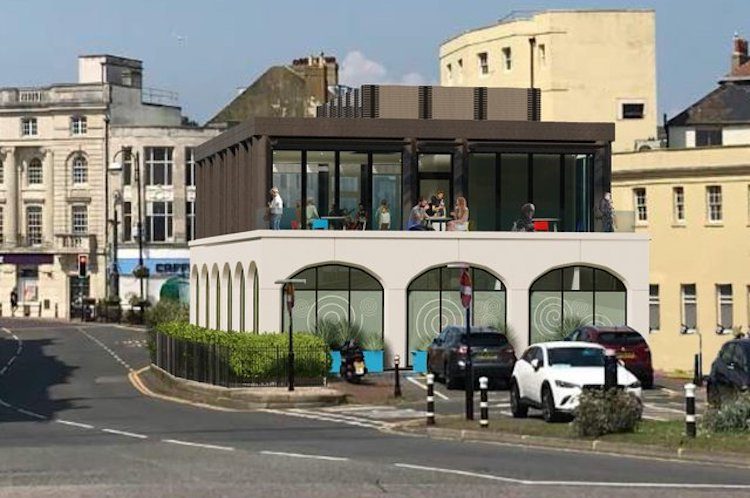What Hastings needs – better training, better schools, better healthcare, and better infrastructure
It was interesting to read Nick Perry’s recent reflections on the Index of Multiple Deprivation (IMD) figures, which show Hastings deteriorating from the 20th most deprived local authority area in the country to the 13th most deprived, relative to all other local authority areas in England writes Peter Chowney, Labour’s prospective parliamentary candidate for Hastings and Rye.
Communities elsewhere in the Hastings and Rye constituency have deteriorated too, particularly parts of Rye, and Camber.

Up until 2010, the Labour government had made significant investments in Hastings, spending over £300m on infrastructure projects. Nick describes these as ‘flashy building projects’.
These ‘flashy projects’ included Hastings College and the Station Plaza Health centre – facilities which have already provided essential health care and a decent education to thousands of local people. Some of that regeneration money did go towards building new office accommodation in the town centre, and industrial units on the Enviro 21 site on South Queensway – all of which are fully occupied.
The Saga building in Priory Square alone created 300 new jobs but a failure to understand what infrastructure spending could achieve was part of the problem when the Liberal Democrats went into coalition with the Tories in government and brought in nine years of austerity that ended such investment.
No more ‘flashy building projects’, an end to new healthcare facilities, an end to better schools and colleges.
But on top of that infrastructure spending, there was also a lot of money invested through Area Based Grants and other funding streams in social and economic projects, building up community structures in the poorest neighbourhoods and running projects, through the council, to set up apprenticeships and other training schemes for young people in the most deprived areas, to begin to tackle the skills shortages and poor educational performance. That had resulted in deprivation levels beginning to reduce.

After 2010, the Liberal Democrat and Tory austerity programme scrapped all that too. And on top of that, the Hastings Borough Council’s core budget was slashed, with £55m cumulatively cut from our £15m annual budget since 2010.
Inevitably, this led to big reductions in services, so much of the community development and training initiative work the council had been doing had to cease.

East Sussex County Council suffered similar cuts, leading to further community projects in Hastings being scrapped. These cuts hit social services and other support programmes for vulnerable people hard too, leading to big increases in homelessness, rough sleeping, and anti-social behaviour, all of which pushed up costs for the borough council as levels of homelessness tripled, and the numbers of people sleeping rough on our streets increased 13-fold.
We know what the reasons for deprivation in Hastings are; poor transport infrastructure means employers won’t relocate here, exacerbated by low skill levels in the local workforce and poor educational achievement, coupled with a lack of support for mental health, addiction, and other social problems.
None of these are things the council can fix without additional funding, and certainly not with the huge funding cuts we’ve had to cope with, at the same time that pressures on council spending have significantly increased.
Over the last nine years, HBC has been very successful at gaining EU and other funding, much of which was targeted on projects to help the most deprived communities.
This included, for example, £2m FLAG funding to support our fishery, £6m CHART funding for employment and social projects in our most deprived wards, funding to support the Coastal Space project to refurbish derelict properties in St Leonards creating around 100 new social rented homes, funding for new factory units, and £500,000 towards building a new Business Start-Up Centre in Hollington, incorporating business skills training (the start-up centre the council already runs is over-subscribed). In 2018 alone, the council was successful in gaining over £10m through competitive external funding bids. But all that’s nowhere near enough.
We did of course approach other universities about establishing a campus in Hastings. None is interested at the moment, in part because of the uncertainty about what impact Brexit will have on overseas students. As for the Hastings United proposals for a sports village that Nick mentions, these were withdrawn by Hastings United because their housing developer pulled out – which was widely reported in the local press.
I’m also a little puzzled about Nick’s comments about council housing in Hastings – HBC hasn’t been a housing provider since the brief Liberal Democrat administration gave all its housing stock away back in the 1990s.
Some of the schemes Nick mentions in his article, such as the Hastings Greenway Project, are worthwhile, but they need proper funding to be realised. He seems to think though that none of these projects need government investment, it’s just up to the council to ‘enable’ them: ‘hand-ups not hand-outs’ as he says. All that’s needed is for the country’s most deprived communities to pull themselves up by their bootstraps, they don’t need any financial investment – it was the policy of the austerity government he supported for all those years. It didn’t work, and it never will.
The responsibility for the shocking inequalities we see in our town and elsewhere, and the failure to address these problems, lies entirely with the government, and stems from those cruel austerity cuts imposed by the Liberal Democrat and Tory Coalition Government back in 2010. Without that, I have no doubt that the programmes in place at the time, if they had remained fully funded, would by now have improved significantly the levels of deprivation in Hastings.
As Nick says, this town, and indeed the Hastings and Rye constituency, is making great strides.
In the arts and cultural sector in particular, we’re recognised nationally as a creative hub in a way that would have seemed impossible a few years ago. But the IMD figures show the stark, underlying truth: some of our communities are the most deprived in the south east, and among the most deprived in the country. We need investment in better training, better schools, better healthcare, and better transport infrastructure. It’s about getting a government that cares about the many not the few, that will provide the funding to get people out of poverty and into worthwhile jobs. We must end the shocking levels of deprivation some of our communities have endured for far too long.




The council housing stock was “given away” while the counxil was hung before the LibDems’ brief leadership of HBC from 1996-1998. I hold no brief for LDs but let’s get the facts right.
Fair point Richard. But I don’t believe the council house ‘giveaway’ was a policy actively pursued by Labour at the time. And was it actually opposed by the Lib Dems?
It was a joint project led by Pam Brown, leader of the LibDems, and Mary Denning, leader of Labour. Both parties supported it as the government had made it clear that funding for council-owned housing would be greatly reduced while housing associations were positively encouraged with increased funding. Also the tenants voted in favour by a large majority. It was a Tory government policy which left councils with little alternative but to support it.
High time everyone stopped blaming everyone else for this….the facts are clear as outlined above by Richard Street. Housing associations were offered increased funding and able to provide suitable housing whilst older council property was costing too much to maintain. Housing associations have overtaken council housing as the preferred alternative and offer good quality housing at fair rents. And housing association properties cannot be sold off to tenants. The sale of council properties did however give many ex-council tenants the opportunity to own their own homes.